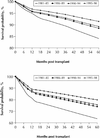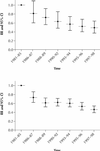Trends in mortality and graft failure for renal transplant patients
- PMID: 12160119
- PMCID: PMC117090
Trends in mortality and graft failure for renal transplant patients
Abstract
Background: Several important advances in general medical management both before and after renal transplantation have occurred over the last 5-15 years, however, few studies have formally examined trends in the outcomes of renal transplantation. We, therefore, aimed to determine the degree to which these advances have resulted in improved outcomes such as survival of patient and graft.
Methods: We analyzed the rates of death and graft failure among the 11,482 Canadians with end-stage renal disease who received a kidney transplant in 1981-98. Patients were followed from the date of transplantation to the date of graft failure, the date of death or the end of the observation period, namely, Dec. 31, 1998, depending on which was the earliest. Rate ratios for mortality and graft failure--ratios of the rate for each calendar period to the rate for the arbitrarily chosen reference period, 1981-85--were estimated with a piece-wise exponential model that adjusted for age, sex, ethnicity, primary renal diagnosis, follow-up time and donor-organ source.
Results: The rates and adjusted rate ratios for death and graft failure decreased significantly and steadily over time. Relative to 1981-85, the adjusted mortality rate ratios were 0.70 (95% confidence interval [CI] 0.54-0.89), 0.65 (95% CI 0.52-0.82) and 0.53 (95% CI 0.41-0.67) for 1986-89, 1990-94 and 1995-98 respectively, and the adjusted graft failure rate ratios were 0.68 (95% CI 0.60-0.78), 0.62 (95% CI 0.54-0.70) and 0.51 (95% CI 0.44-0.58) respectively. The decrease was mostly among the cadaveric-organ recipients. Calendar period was as important a predictor of outcome as well-known prognostic factors such as age and primary renal diagnosis.
Interpretation: Decreases in mortality rates are probably related to refinements in patient management. Decreases in graft failure rates are probably the result of a combination of improved immunotherapy and better management of nonimmunologic conditions such as hypertension and hyperlipidemia.
Figures


Similar articles
-
Survival on dialysis post-kidney transplant failure: results from the Scientific Registry of Transplant Recipients.Am J Kidney Dis. 2007 Feb;49(2):294-300. doi: 10.1053/j.ajkd.2006.11.022. Am J Kidney Dis. 2007. PMID: 17261432
-
Impact of graft failure on patient survival on dialysis: a comparison of transplant-naive and post-graft failure mortality rates.Nephrol Dial Transplant. 2005 Feb;20(2):387-91. doi: 10.1093/ndt/gfh595. Epub 2004 Dec 7. Nephrol Dial Transplant. 2005. PMID: 15585512
-
Liver transplantation in the United States: a report from the UNOS Liver Transplant Registry.Clin Transpl. 1999:23-34. Clin Transpl. 1999. PMID: 11038623
-
The UNOS Scientific Renal Transplant Registry.Clin Transpl. 1999:1-21. Clin Transpl. 1999. PMID: 11038622
-
Lymphoproliferative disorders after adult kidney transplant: epidemiology and comparison of registry report with claims-based diagnoses.Am J Kidney Dis. 2011 Dec;58(6):971-80. doi: 10.1053/j.ajkd.2011.07.015. Epub 2011 Sep 17. Am J Kidney Dis. 2011. PMID: 21930332
Cited by
-
Outcomes of adult cadaveric renal transplantation in ireland 1986 to 2001.Ir J Med Sci. 2005 Jan-Mar;174(1):42-8. doi: 10.1007/BF03168518. Ir J Med Sci. 2005. PMID: 15868889
-
Causes of death in renal transplant recipients with functioning allograft.Indian J Nephrol. 2012 Jul;22(4):264-8. doi: 10.4103/0971-4065.101245. Indian J Nephrol. 2012. PMID: 23162269 Free PMC article.
References
-
- Wolfe RA, Ashby VB, Milford EL, Ojo AO, Ettenger RE, Agodoa LYC, et al. Comparison of mortality in all patients on dialysis, patients on dialysis awaiting transplantation, and recipients of a first cadaveric transplant. N Engl J Med 1999;341:1725-30. - PubMed
-
- Laupacis AL, Keown P, Pus N, Krueger H, Ferguson B, Wing C, et al. A study of the quality of life and cost-utility of renal transplantation. Kidney Int 1996;50:235-42. - PubMed
-
- Russell JD, Beecroft ML, Ludwin D, Churchill DN. The quality of life in renal transplantation — a prospective study. Transplantation 1992;54:656-60. - PubMed
-
- Eggers P. Comparison of treatment costs between dialysis and transplantation. Semin Nephrol 1992;12:284-9. - PubMed
-
- First MR. Transplantation in the nineties. Transplantation 1992;53:1-11. - PubMed
Publication types
MeSH terms
LinkOut - more resources
Full Text Sources
Medical
Research Materials
